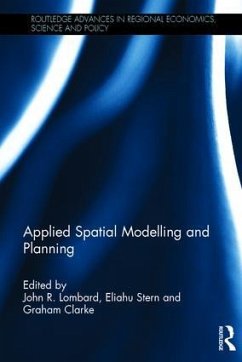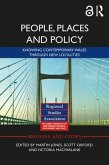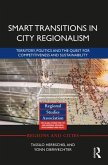Applied Spatial Modelling and Planning
Herausgeber: Lombard, John R; Clarke, Graham; Stern, Eliahu
Applied Spatial Modelling and Planning
Herausgeber: Lombard, John R; Clarke, Graham; Stern, Eliahu
- Gebundenes Buch
- Merkliste
- Auf die Merkliste
- Bewerten Bewerten
- Teilen
- Produkt teilen
- Produkterinnerung
- Produkterinnerung
Applied Spatial Modelling and Planning shows how much geographical research is policy relevant to a wide variety of agencies through the use of GIS and spatial modelling in applied geography. It shows how these techniques have been used to address 'real world' issues that are of concern to international organisations, public agencies and businesses as illustrated by actual funded projects that geographers have developed collaboratively with end-users.
Andere Kunden interessierten sich auch für
![Post-Metropolitan Territories Post-Metropolitan Territories]() Post-Metropolitan Territories229,99 €
Post-Metropolitan Territories229,99 €![People, Places and Policy People, Places and Policy]() People, Places and Policy200,99 €
People, Places and Policy200,99 €![Urban Recycling Cooperatives Urban Recycling Cooperatives]() Jutta GutberletUrban Recycling Cooperatives229,99 €
Jutta GutberletUrban Recycling Cooperatives229,99 €![The European Territory The European Territory]() Jacques RobertThe European Territory240,99 €
Jacques RobertThe European Territory240,99 €![The Scottish Economy The Scottish Economy]() The Scottish Economy198,99 €
The Scottish Economy198,99 €![Smart Transitions in City Regionalism Smart Transitions in City Regionalism]() Tassilo HerrschelSmart Transitions in City Regionalism197,99 €
Tassilo HerrschelSmart Transitions in City Regionalism197,99 €![The Political Economy of Capital Cities The Political Economy of Capital Cities]() Heike MayerThe Political Economy of Capital Cities197,99 €
Heike MayerThe Political Economy of Capital Cities197,99 €-
-
-
Applied Spatial Modelling and Planning shows how much geographical research is policy relevant to a wide variety of agencies through the use of GIS and spatial modelling in applied geography. It shows how these techniques have been used to address 'real world' issues that are of concern to international organisations, public agencies and businesses as illustrated by actual funded projects that geographers have developed collaboratively with end-users.
Hinweis: Dieser Artikel kann nur an eine deutsche Lieferadresse ausgeliefert werden.
Hinweis: Dieser Artikel kann nur an eine deutsche Lieferadresse ausgeliefert werden.
Produktdetails
- Produktdetails
- Verlag: Taylor & Francis
- Seitenzahl: 394
- Erscheinungstermin: 8. September 2016
- Englisch
- Abmessung: 236mm x 157mm x 25mm
- Gewicht: 739g
- ISBN-13: 9781138925700
- ISBN-10: 1138925705
- Artikelnr.: 43032592
- Herstellerkennzeichnung
- Libri GmbH
- Europaallee 1
- 36244 Bad Hersfeld
- gpsr@libri.de
- Verlag: Taylor & Francis
- Seitenzahl: 394
- Erscheinungstermin: 8. September 2016
- Englisch
- Abmessung: 236mm x 157mm x 25mm
- Gewicht: 739g
- ISBN-13: 9781138925700
- ISBN-10: 1138925705
- Artikelnr.: 43032592
- Herstellerkennzeichnung
- Libri GmbH
- Europaallee 1
- 36244 Bad Hersfeld
- gpsr@libri.de
John R. Lombard is an Associate Professor in the School of Public Service at Old Dominion University, USA. Eliahu Stern is Professor of Geography and Planning at Ben-Gurion University of the Negev, Beer Sheva, Israel. Graham Clarke is Professor of Business Geography at the University of Leeds, UK.
Chapter 1: Introduction John Lombard, Eli Stern and Graham Clarke
Chapter 2: Applied spatial modelling: 'big science' and 'best practice'
challenges Sir Alan Wilson
Part I Dynamics of economic space
Chapter 3: An exploratory analysis of new firm formation in New England
Jitendra Parajuli and Kingsley E. Haynes
Chapter 4: The impacts of policy changes on overseas human captial in
Australia: the implementation of the 485 graduate visa Jonathan Corcoran,
Francisco Rowe, Alessandra Faggian, and Robert Stimson
Chapter 5: On the three 'laws' of spatial interaction and a string theory
finale: perspectives from social physics with examples in the digital and
retail economy Robert G.V. Baker
Part II Housing and settlements
Chapter 6: Spatial typology of the private rental housing market at
neighbourhood scale: the case of South East Queensland, Australia Yan Liu,
David Wadley and Jonathan Corcoran
Chapter 7: Optimal kernel and bandwidth specifications for geographically
weighted regression: an evaluation using automated valuation models (AVMS)
for mass real estate appraisal Paul E. Bidanset and John R. Lombard
Chapter 8: Spatial search: new settlements for Israel's ultra-orthodox
population Eliahu Stern
Chapter 9: A tale of two earthquakes: dynamic agent-based simulation of
urban resilience A. Yair Grinberger and Daniel Felsenstein
Part III Population dynamics and population ageing
Chapter 10: The United Kingdom's multi-ethnic future: how fast is it
arriving? Philip Rees, Pia Wohland and Paul Norman
Chapter 11: Decomposition of life expectancy at older ages and prospects
for ageing populations Leslie Mayhew and David Smith
Chapter 12: Using agent-based modelling to understand crime phenomena Nick
Addis
Part IV Health care planning and analysis
Chapter 13: Modelling the impact of new community hospitals on access to
health care Holly Shulman, Graham Clarke and Mark Birkin
Chapter 14: SimSALUD - towards a health decision support system for
regional planning Melanie N. Tomintz and Victor M. Garcia-Barrios
Chapter 15: Small-scale agent-based modelling of infectious disease
transmission: an example in a primary school Mike Bithell
Chapter 16: Exploring small-area geographies of obesity in the UK: evidence
from the UK Women's Cohort Study Michelle A. Morris, Graham Clarke,
Kimberley L. Edwards, Claire Hulme and Janet E. Cade
Chapter 17: Examining the socio-spatial determinants of depression in the
UK Karyn Morrissey, Peter Kinderman, Eleanor Pontin, Sara Tai and Matthias
Schwannauer
Part V Environmental modelling
Chapter 18: A case study of flooding in the Limpopo River Basin, Xai-Xai,
Mozambique Robert Fligg and Joana Barros
Chapter 19: A computational framework for mitigating land degradation: a
synergy of knowledge from physical geography and geoinformatics Tal Svoray
Chapter 2: Applied spatial modelling: 'big science' and 'best practice'
challenges Sir Alan Wilson
Part I Dynamics of economic space
Chapter 3: An exploratory analysis of new firm formation in New England
Jitendra Parajuli and Kingsley E. Haynes
Chapter 4: The impacts of policy changes on overseas human captial in
Australia: the implementation of the 485 graduate visa Jonathan Corcoran,
Francisco Rowe, Alessandra Faggian, and Robert Stimson
Chapter 5: On the three 'laws' of spatial interaction and a string theory
finale: perspectives from social physics with examples in the digital and
retail economy Robert G.V. Baker
Part II Housing and settlements
Chapter 6: Spatial typology of the private rental housing market at
neighbourhood scale: the case of South East Queensland, Australia Yan Liu,
David Wadley and Jonathan Corcoran
Chapter 7: Optimal kernel and bandwidth specifications for geographically
weighted regression: an evaluation using automated valuation models (AVMS)
for mass real estate appraisal Paul E. Bidanset and John R. Lombard
Chapter 8: Spatial search: new settlements for Israel's ultra-orthodox
population Eliahu Stern
Chapter 9: A tale of two earthquakes: dynamic agent-based simulation of
urban resilience A. Yair Grinberger and Daniel Felsenstein
Part III Population dynamics and population ageing
Chapter 10: The United Kingdom's multi-ethnic future: how fast is it
arriving? Philip Rees, Pia Wohland and Paul Norman
Chapter 11: Decomposition of life expectancy at older ages and prospects
for ageing populations Leslie Mayhew and David Smith
Chapter 12: Using agent-based modelling to understand crime phenomena Nick
Addis
Part IV Health care planning and analysis
Chapter 13: Modelling the impact of new community hospitals on access to
health care Holly Shulman, Graham Clarke and Mark Birkin
Chapter 14: SimSALUD - towards a health decision support system for
regional planning Melanie N. Tomintz and Victor M. Garcia-Barrios
Chapter 15: Small-scale agent-based modelling of infectious disease
transmission: an example in a primary school Mike Bithell
Chapter 16: Exploring small-area geographies of obesity in the UK: evidence
from the UK Women's Cohort Study Michelle A. Morris, Graham Clarke,
Kimberley L. Edwards, Claire Hulme and Janet E. Cade
Chapter 17: Examining the socio-spatial determinants of depression in the
UK Karyn Morrissey, Peter Kinderman, Eleanor Pontin, Sara Tai and Matthias
Schwannauer
Part V Environmental modelling
Chapter 18: A case study of flooding in the Limpopo River Basin, Xai-Xai,
Mozambique Robert Fligg and Joana Barros
Chapter 19: A computational framework for mitigating land degradation: a
synergy of knowledge from physical geography and geoinformatics Tal Svoray
Chapter 1: Introduction John Lombard, Eli Stern and Graham Clarke
Chapter 2: Applied spatial modelling: 'big science' and 'best practice'
challenges Sir Alan Wilson
Part I Dynamics of economic space
Chapter 3: An exploratory analysis of new firm formation in New England
Jitendra Parajuli and Kingsley E. Haynes
Chapter 4: The impacts of policy changes on overseas human captial in
Australia: the implementation of the 485 graduate visa Jonathan Corcoran,
Francisco Rowe, Alessandra Faggian, and Robert Stimson
Chapter 5: On the three 'laws' of spatial interaction and a string theory
finale: perspectives from social physics with examples in the digital and
retail economy Robert G.V. Baker
Part II Housing and settlements
Chapter 6: Spatial typology of the private rental housing market at
neighbourhood scale: the case of South East Queensland, Australia Yan Liu,
David Wadley and Jonathan Corcoran
Chapter 7: Optimal kernel and bandwidth specifications for geographically
weighted regression: an evaluation using automated valuation models (AVMS)
for mass real estate appraisal Paul E. Bidanset and John R. Lombard
Chapter 8: Spatial search: new settlements for Israel's ultra-orthodox
population Eliahu Stern
Chapter 9: A tale of two earthquakes: dynamic agent-based simulation of
urban resilience A. Yair Grinberger and Daniel Felsenstein
Part III Population dynamics and population ageing
Chapter 10: The United Kingdom's multi-ethnic future: how fast is it
arriving? Philip Rees, Pia Wohland and Paul Norman
Chapter 11: Decomposition of life expectancy at older ages and prospects
for ageing populations Leslie Mayhew and David Smith
Chapter 12: Using agent-based modelling to understand crime phenomena Nick
Addis
Part IV Health care planning and analysis
Chapter 13: Modelling the impact of new community hospitals on access to
health care Holly Shulman, Graham Clarke and Mark Birkin
Chapter 14: SimSALUD - towards a health decision support system for
regional planning Melanie N. Tomintz and Victor M. Garcia-Barrios
Chapter 15: Small-scale agent-based modelling of infectious disease
transmission: an example in a primary school Mike Bithell
Chapter 16: Exploring small-area geographies of obesity in the UK: evidence
from the UK Women's Cohort Study Michelle A. Morris, Graham Clarke,
Kimberley L. Edwards, Claire Hulme and Janet E. Cade
Chapter 17: Examining the socio-spatial determinants of depression in the
UK Karyn Morrissey, Peter Kinderman, Eleanor Pontin, Sara Tai and Matthias
Schwannauer
Part V Environmental modelling
Chapter 18: A case study of flooding in the Limpopo River Basin, Xai-Xai,
Mozambique Robert Fligg and Joana Barros
Chapter 19: A computational framework for mitigating land degradation: a
synergy of knowledge from physical geography and geoinformatics Tal Svoray
Chapter 2: Applied spatial modelling: 'big science' and 'best practice'
challenges Sir Alan Wilson
Part I Dynamics of economic space
Chapter 3: An exploratory analysis of new firm formation in New England
Jitendra Parajuli and Kingsley E. Haynes
Chapter 4: The impacts of policy changes on overseas human captial in
Australia: the implementation of the 485 graduate visa Jonathan Corcoran,
Francisco Rowe, Alessandra Faggian, and Robert Stimson
Chapter 5: On the three 'laws' of spatial interaction and a string theory
finale: perspectives from social physics with examples in the digital and
retail economy Robert G.V. Baker
Part II Housing and settlements
Chapter 6: Spatial typology of the private rental housing market at
neighbourhood scale: the case of South East Queensland, Australia Yan Liu,
David Wadley and Jonathan Corcoran
Chapter 7: Optimal kernel and bandwidth specifications for geographically
weighted regression: an evaluation using automated valuation models (AVMS)
for mass real estate appraisal Paul E. Bidanset and John R. Lombard
Chapter 8: Spatial search: new settlements for Israel's ultra-orthodox
population Eliahu Stern
Chapter 9: A tale of two earthquakes: dynamic agent-based simulation of
urban resilience A. Yair Grinberger and Daniel Felsenstein
Part III Population dynamics and population ageing
Chapter 10: The United Kingdom's multi-ethnic future: how fast is it
arriving? Philip Rees, Pia Wohland and Paul Norman
Chapter 11: Decomposition of life expectancy at older ages and prospects
for ageing populations Leslie Mayhew and David Smith
Chapter 12: Using agent-based modelling to understand crime phenomena Nick
Addis
Part IV Health care planning and analysis
Chapter 13: Modelling the impact of new community hospitals on access to
health care Holly Shulman, Graham Clarke and Mark Birkin
Chapter 14: SimSALUD - towards a health decision support system for
regional planning Melanie N. Tomintz and Victor M. Garcia-Barrios
Chapter 15: Small-scale agent-based modelling of infectious disease
transmission: an example in a primary school Mike Bithell
Chapter 16: Exploring small-area geographies of obesity in the UK: evidence
from the UK Women's Cohort Study Michelle A. Morris, Graham Clarke,
Kimberley L. Edwards, Claire Hulme and Janet E. Cade
Chapter 17: Examining the socio-spatial determinants of depression in the
UK Karyn Morrissey, Peter Kinderman, Eleanor Pontin, Sara Tai and Matthias
Schwannauer
Part V Environmental modelling
Chapter 18: A case study of flooding in the Limpopo River Basin, Xai-Xai,
Mozambique Robert Fligg and Joana Barros
Chapter 19: A computational framework for mitigating land degradation: a
synergy of knowledge from physical geography and geoinformatics Tal Svoray








